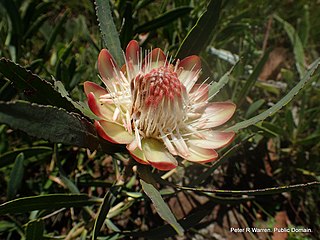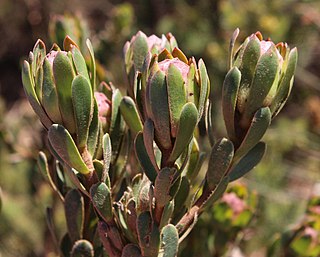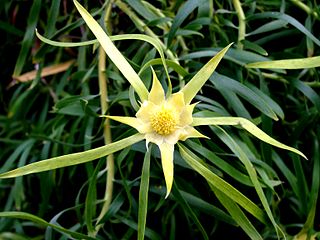
Protea roupelliae is a species of Protea in the large family Proteaceae, and was named to commemorate Arabella Elizabeth Roupell (1817-1914) who spent two years in Cape Town and painted local flowers for her own pleasure. This species is also known as the silver sugarbush.

Protea simplex, the dwarf grassveld sugarbush, is a flower-bearing shrub belonging to the genus Protea. It is native to South Africa.

Protea subulifolia, the awl-leaf sugarbush, is a flower-bearing shrub belonging to the Protea genus. The plant is native to the Western Cape and occurs from the Stettynskloof to Riviersonderendberge, Langeberg, Bot River to the Elim plain. The plant grows 50 cm in diameter and 70 cm tall and flowers from July to September.
Leucadendron cadens, the Witteberg sunbush, is a flower-bearing shrub that belongs to the genus Leucadendron and forms part of the fynbos. The plant is native to the Western Cape, South Africa. The plant is rare.
Leucadendron cinereum, the scraggly conebush, is a flower-bearing shrub that belongs to the genus Leucadendron and forms part of the fynbos. The plant is native to the Western Cape where it occurs from Hopefield and on the Cape Flats from the Berg River estuary to Kraaifontein.

Leucadendron stelligerum, the Agulhas conebush, is a flower-bearing shrub that belongs to the genus Leucadendron and forms part of the fynbos. The plant is native to the Western Cape where it occurs from Elim to the Agulhas Plain.
Leucadendron cryptocephalum, the concealed conebush, is a flower-bearing shrub that belongs to the genus Leucadendron and forms part of the fynbos. The plant is native to the Western Cape and only two populations occur at Potberg and the Groenlandberg. There is little information available about the plant.

Leucadendron floridum, the flats conebush, is a flower-bearing shrub belonging to the genus Leucadendron and forms part of the fynbos. The plant is native to the Western Cape, where it occurs in the Cape Flats, from Rondebosch to Kuils River and also in the Cape Peninsula around most wetlands. The shrub grows 2 m tall and bears flowers from September to October.

Leucadendron eucalyptifolium, the gum-leaved conebush, is a flower-bearing shrub belonging to the genus Leucadendron and forms part of the fynbos. The plant is native to the Western Cape and the Eastern Cape, where it occurs in the Potberg, Riversdal Plains, Langeberg, Outeniqua Mountains, Tsitsikamma Mountains, Kouga Mountains, Elandsberg, Swartberg, Waboomsberg, Warmwaterberg, Touwsberg, Rooiberg and Soetwaterberg. The shrub grows 4 m tall and bears flowers from July to October.

Leucadendron spissifolium subsp. fragrans, the fragrant spear-leaf conebush, is a flower-bearing shrub belonging to the genus Leucadendron. The plant is native to the Western Cape and occurs in the Langeberg and Outeniqua Mountains from Gysmanshoek to the Woodville Forest Reserve, as well as the Swartberg and Kammanassie Mountains. It forms part of the fynbos.

Leucadendron spissifolium subsp. spissifolium, the common spear-leaf conebush, is a flower-bearing shrub belonging to the genus Leucadendron and forms part of the fynbos. The plant is native to the Western Cape where it occurs on the Gifberg and from the Cederberg to the Cape Peninsula and Kogelberg to Kampscheberg in the Langeberg.
Leucadendron foedum, the Hopefield conebush, is a flower-bearing shrub belonging to the genus Leucadendron and forms part of the fynbos. The plant is native to the Western Cape, South Africa, and occurs from Piketberg to Hopefield.
Leucadendron sheilae, the Lokenberg conebush, is a flower-bearing shrub that belongs to the genus Leucadendron and forms part of the fynbos, a South African biogeographical region. The plant is native to the Western and Northern Capes, where it occurs at Lokenberg in the Bokkeveld Mountains. The plant grows mainly in hard sandstone sand on level crests at altitudes of 600 to 900 metres (2,000–3,000 ft). In Afrikaans it is known as Lokenberg-tolbos.

Spatalla longifolia, the pink-stalked spoon, is a flower-bearing shrub that belongs to the genus Spatalla. It forms a part of the fynbos. The plant is native to the Western Cape where it is found in the Hottentots-Holland Mountains; from Franschhoek and Villiersdorp to the Kleinmond Mountains.
Aulax cancellata, the channel-leaf featherbush, is a shrub that is native to the Western Cape and the Eastern Cape and belongs to the genus Aulax. This plant is widespread, it occurs on the Cape Peninsula, Hottentots-Holland Mountains to the Langeberg and Kouga Mountains, Swartberg and Kammanassie Mountains. The shrub grows upright with a single stem and grows up to 2.5 m tall.
Serruria candicans, the shiny spiderhead, is a flower-bearing shrub that belongs to the genus Serruria and forms part of the fynbos. The plant is native to the Western Cape, where it occurs from Elandskloof to the Slanghoek Mountains and Paardeberg at Malmesbury. The shrub is erect and grows only 80 cm tall and bears flowers from July to December.
Spatalla nubicola, the Medusa spoon, is a flower-bearing shrub that belongs to the genus Spatalla and forms part of the fynbos. The plant is native to the Western Cape where it is found in the central Langeberg near the town of Heidelberg.
Spatalla prolifera, the palmiet spoon, is a flower-bearing shrub that belongs to the genus Spatalla and forms part of the fynbos. The plant is native to the Western Cape, South Africa.
Spatalla caudata, the woolly-hair spoon, is a flower-bearing shrub that belongs to the genus Spatalla and forms part of the fynbos. The plant is native to the Western Cape where it is found in the Cederberg, Groot Winterhoek Mountains and Hex River Mountains.
Spatalla colorata, the shiny spoon, is a flower-bearing shrub that belongs to the genus Spatalla and forms part of the fynbos. The plant is native to the Western Cape where it occurs from the Riviersonderend Mountains to central Langeberg.








